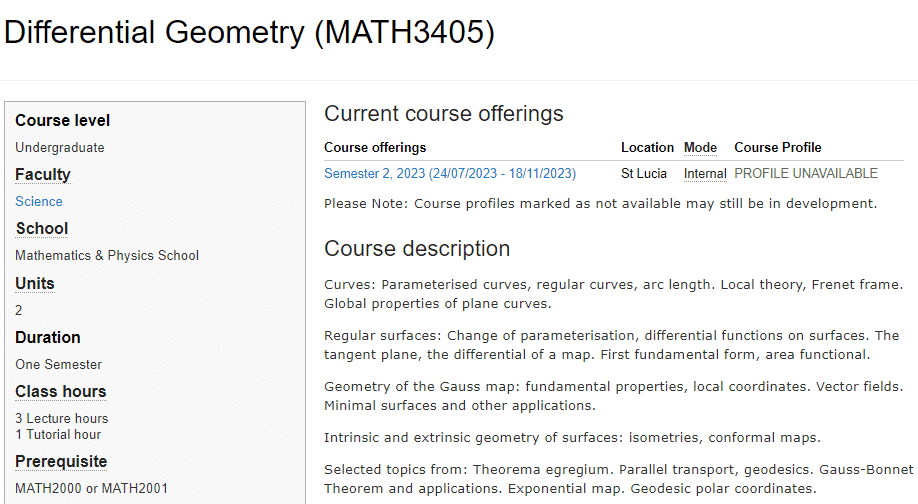MY-ASSIGNMENTEXPERT™可以为您提供my.uq.edu.au MATH3405 Differential geometry微分几何的代写代考和辅导服务!
这是昆士兰大学 微分几何课程的代写成功案例。

MATH3405课程简介
Curves: Parameterised curves, regular curves, arc length. Local theory, Frenet frame. Global properties of plane curves.
Regular surfaces: Change of parameterisation, differential functions on surfaces. The tangent plane, the differential of a map. First fundamental form, area functional.
Geometry of the Gauss map: fundamental properties, local coordinates. Vector fields. Minimal surfaces and other applications.
Intrinsic and extrinsic geometry of surfaces: isometries, conformal maps.
Selected topics from: Theorema egregium. Parallel transport, geodesics. Gauss-Bonnet Theorem and applications. Exponential map. Geodesic polar coordinates.
Prerequisites
The prerequisite for this course is MATH2000 (or MATH2001), and I will assume knowledge of the concepts and methods introduced there (and in its prerequisites MATH1051 and MATH1052). There are two recommended prerequisites, MATH2400 and MATH2301. They are recommended not so much for content, but rather for general mathematical training.
If you wish to revise the background material, it should suffice to go over the notes, homework, assignments and exams of the prerequisite. If you feel enthusiastic, an excellent way of revising and deepening this material would be to work through Michael Spivak’s “Calculus on Manifolds,” which starts with the inner product on Rn and ends with Green’s Theorem and the Divergence Theorem.
MATH3405 Differential geometry HELP(EXAM HELP, ONLINE TUTOR)
A Riemannian submanifold $M \subset(\bar{M}, \bar{g})$ with the induced metric $g=\left.\bar{g}\right|_{T M}$ is called totally geodesic if for every $p \in M, v \in T_p M$, the $\bar{g}$-geodesic $\gamma$ with initial conditions $\gamma(0)=p, \gamma^{\prime}(0)=v$ lies in $M$. Show the following are equivalent:
$M$ is totally geodesic.
Every $g$-geodesic in $M$ is also a $\bar{g}$-geodesic in $\bar{M}$.
The second fundamental form of $M$ vanishes.
Solution:
Let $\bar{\nabla}$ be the connection on $\bar{M}$ and let $\nabla$ be the induced connection on $M$. Take $p \in M, v \in$ $T_p M$ and let $\gamma$ be a $g$-geodesic with $\gamma(0)=p, \gamma^{\prime}(0)=v$ and let $\bar{\gamma}$ be a $\bar{g}$-geodesic with $\bar{\gamma}(0)=\gamma(0)$ and $\bar{\gamma}^{\prime}(0)=\gamma^{\prime}(0)$. First we will show that statement 1 implies statement 2 . If $M$ is totally geodesic, then $\bar{\gamma}$ lies in $M$, so $\bar{\gamma}^{\prime}(t) \in T_{\bar{\gamma}(t)} M$ and hence $\nabla_{\bar{\gamma}^{\prime}(t)} \bar{\gamma}^{\prime}(t)=\bar{\nabla}{\bar{\gamma}^{\prime}(t)} \bar{\gamma}^{\prime}(t)=0$ for any $t$, so $\bar{\gamma}=\gamma$ by the uniqueness of solutions for ODE’s. Hence, every $g$-geodesic is a $\bar{g}$-geodesic. Now, assuming statement 2 holds, we have $\nabla{\gamma^{\prime}(0)} \gamma^{\prime}(0)=\bar{\nabla}{\bar{\gamma}^{\prime}(0)} \bar{\gamma}^{\prime}(0)$, it follows that $$ \left.I I\right|_p(v, v)=-\nabla{\gamma^{\prime}(0)} \gamma^{\prime}(0)+\bar{\nabla}{\bar{\gamma}^{\prime}(0)} \bar{\gamma}^{\prime}(0)=0 $$ so $I I=0$ for any $p, v$, which is statement 3. Finally, if $I I \equiv 0$, then $\bar{\nabla}{\bar{\gamma}^{\prime}} \bar{\gamma}^{\prime}=\nabla_{\gamma^{\prime}} \gamma^{\prime}+I I\left(\gamma^{\prime}, \gamma^{\prime}\right)=0$, so $\bar{\gamma}$ lies in $M$ and so $M$ is totally geodesic.
Let $M \subset \mathbb{R}^3$ be the catenoid, which is the surface of revolution obtained by revolving the curve $x=\cosh z$ around the $z$-axis. Show that $M$ has zero mean curvature.
Solution:
We can parametrize the catenoid by
$$
F(\theta, z)=(\cosh (z) \cos \theta, \cosh (z) \sin \theta, z)
$$
for $\theta \in[0,2 \pi)$ and $z \in \mathbb{R}$. Now, we calculate
$$
\begin{gathered}
\partial_\theta F=(-\cosh (z) \sin \theta, \cosh (z) \cos \theta, 0) \
\partial_z F=(\sinh (z) \cos \theta, \sinh (z) \sin \theta, 1)
\end{gathered}
$$
and so we see that $g_{i j}=\cosh ^2(z) \delta_{i j}$. Choose an outward unit normal $\nu=\left(1+\sinh ^2(z)\right)^{-1 / 2}(-\cos \theta,-\sin \theta, \sinh (z))$. In coordinates, the scalar second fundamental form then becomes $h_{i j}=\partial_{i j}^2 F \cdot \nu$, so we have
$$
\begin{gathered}
h_{\theta \theta}=\cosh (z)\left(1+\sinh ^2(z)\right)^{-1 / 2}=1 \
h_{\theta z}=h_{z \theta}=0 \
h_{z z}=-\cosh (z)\left(1+\sinh ^2(z)\right)^{-1 / 2}=-1
\end{gathered}
$$
and so
$$
h_j^i=g^{i p} h_{p j}=\frac{1}{\cosh ^2(z)}\left(\begin{array}{cc}
1 & 0 \
0 & -1
\end{array}\right)
$$
Since the mean curvature is the trace of $h_j^i$, we see that the mean curvature must vanish.
A geodesic triangle in a Riemannian 2-manifold $\left(M^2, g\right)$ is a domain $\Omega$ with piecewise-smooth boundary $\partial \Omega$ consisting of three geodesics meeting at three vertices. If $M$ has constant Gauss curvature $K$, show that the sum of interior angles of any geodesic triangle is $\pi+K A$ where $A$ is the area of $\Omega$.
Solution:
Recall that by the Gauss-Bonnet theorem, if $\Omega$ is a curved polygon in $\left(M^2, g\right)$, then
$$
\int_{\Omega} K+\int_{\partial \Omega} k+\sum \varepsilon_i=2 \pi \chi(\Omega)
$$
where $k$ is the geodesic curvature of $\partial \Omega, \varepsilon_i$ are the exterior angles of $\Omega$, and $\chi(\Omega)$ is the Euler characteristic of $\Omega$. If $\Omega$ is a geodesic triangle, then $\chi(\Omega)=1, \partial \Omega$ has zero geodesic curvature, and $\sum_{i=1}^3 \varepsilon_i=3 \pi-\sum_{i=1}^3 \theta_i$, where $\theta_i$ are the interior angles. Hence, if $K$ is constant,
$$
K A+3 \pi-\sum_{i=1}^3 \theta_i=2 \pi
$$
or, equivalently
$$
\sum_{i=1}^3 \theta_i=\pi+K A
$$

MY-ASSIGNMENTEXPERT™可以为您提供MY.UQ.EDU.AU MATH3405 DIFFERENTIAL GEOMETRY微分几何的代写代考和辅导服务!

